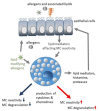Modulation of Mast Cell Reactivity by Lipids: The Neglected Side of Allergic Diseases
- PMID: 31191542
- PMCID: PMC6549522
- DOI: 10.3389/fimmu.2019.01174
Modulation of Mast Cell Reactivity by Lipids: The Neglected Side of Allergic Diseases
Abstract
Mast cells (MCs) have long been mainly regarded as effector cells in IgE-associated allergic disorders with potential immunoregulatory roles. Located close to the allergen entry sites in the skin and mucosa, MCs can capture foreign substances such as allergens, toxins, or noxious substances and are exposed to the danger signals produced by epithelial cells. MC reactivity shaped by tissue-specific factors is crucial for allergic responses ranging from local skin reactions to anaphylactic shock. Development of Th2 response leading to allergen-specific IgE production is a prerequisite for MC sensitization and induction of FcεRI-mediated MC degranulation. Up to now, IgE production has been mainly associated with proteins, whereas lipids present in plant pollen grains, mite fecal particles, insect venoms, or food have been largely overlooked regarding their immunostimulatory and immunomodulatory properties. Recent studies, however, have now demonstrated that lipids affect the sensitization process by modulating innate immune responses of epithelial cells, dendritic cells, and NK-T cells and thus crucially contribute to the outcome of sensitization. Whether and how lipids affect also MC effector functions in allergic reactions has not yet been fully clarified. Here, we discuss how lipids can affect MC responses in the context of allergic inflammation. Direct effects of immunomodulatory lipids on MC degranulation, changes in local lipid composition induced by allergens themselves and changes in lipid transport affecting MC reactivity are possible mechanisms by which the function of MC might be modulated.
Keywords: allergy; degranulation; flippases; floppases; lipid mediators; lipids; mast cells; scramblases.
Figures


Similar articles
-
Positive and negative roles of lipids in mast cells and allergic responses.Curr Opin Immunol. 2021 Oct;72:186-195. doi: 10.1016/j.coi.2021.06.001. Epub 2021 Jun 23. Curr Opin Immunol. 2021. PMID: 34174696 Review.
-
Lipid Mediators From Timothy Grass Pollen Contribute to the Effector Phase of Allergy and Prime Dendritic Cells for Glycolipid Presentation.Front Immunol. 2019 May 7;10:974. doi: 10.3389/fimmu.2019.00974. eCollection 2019. Front Immunol. 2019. PMID: 31134071 Free PMC article.
-
FcepsilonRI-alpha siRNA inhibits the antigen-induced activation of mast cells.Iran J Allergy Asthma Immunol. 2009 Dec;8(4):177-83. Iran J Allergy Asthma Immunol. 2009. PMID: 20404387
-
Sensitization of skin mast cells with IgE antibodies to Culicoides allergens occurs frequently in clinically healthy horses.Vet Immunol Immunopathol. 2009 Nov 15;132(1):53-61. doi: 10.1016/j.vetimm.2009.09.015. Epub 2009 Sep 23. Vet Immunol Immunopathol. 2009. PMID: 19836083
-
Immunomodulatory Significance of Mast Cell Exosomes (MC-EXOs) in Immune Response Coordination.Clin Rev Allergy Immunol. 2025 Feb 20;68(1):20. doi: 10.1007/s12016-025-09033-6. Clin Rev Allergy Immunol. 2025. PMID: 39976807 Free PMC article. Review.
Cited by
-
Integrative lipidomic features identify plasma lipid signatures in chronic urticaria.Front Immunol. 2022 Jul 28;13:933312. doi: 10.3389/fimmu.2022.933312. eCollection 2022. Front Immunol. 2022. PMID: 35967440 Free PMC article.
-
Anaphylaxie auf Zusatzstoffe in Impfstoffen.Allergo J. 2022;31(5):22-39. doi: 10.1007/s15007-022-5054-3. Epub 2022 Jul 25. Allergo J. 2022. PMID: 35911653 Free PMC article. Review. German.
-
Development of mouse model for oral allergy syndrome to identify IgE cross-reactive pollen and food allergens: ragweed pollen cross-reacts with fennel and black pepper.Front Immunol. 2022 Jul 25;13:945222. doi: 10.3389/fimmu.2022.945222. eCollection 2022. Front Immunol. 2022. PMID: 35958602 Free PMC article.
-
Anti-Allergic Effect of Dietary Polyphenols Curcumin and Epigallocatechin Gallate via Anti-Degranulation in IgE/Antigen-Stimulated Mast Cell Model: A Lipidomics Perspective.Metabolites. 2023 May 5;13(5):628. doi: 10.3390/metabo13050628. Metabolites. 2023. PMID: 37233669 Free PMC article.
-
Mast cells contribute to the resolution of allergic inflammation by releasing resolvin D1.Pharmacol Res. 2023 Mar;189:106691. doi: 10.1016/j.phrs.2023.106691. Epub 2023 Feb 10. Pharmacol Res. 2023. PMID: 36773709 Free PMC article.
References
Publication types
MeSH terms
Substances
LinkOut - more resources
Full Text Sources

